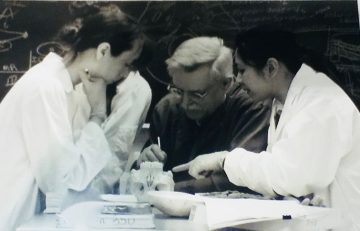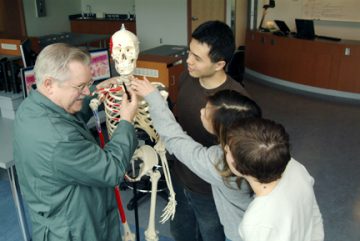
How do I begin to write about my mentor, my teacher, and my friend, Dr. Crawford?
First of all, it may seem strange that I would call someone so close to me Dr. Crawford instead of by his first name. He did tell me to call him Bruce at some point in those early days. However, he had both an MD and a PhD, so I called him Dr. Crawford. How could you not? He was a doctor two times over! I called him Dr. Crawford initially out of respect, then as a habit so I wouldn’t call him Bruce in front of the students. Eventually, Dr. Crawford just became the name I know him by. To me, it is a name of respect and endearment; like calling someone Father instead of Dad. Dr. Crawford will always be my IMP father, even though he often seemed more grandfatherly. He was old fashioned in all of the best ways — he worked hard, with consistent integrity, a sensible practicality, and an absence of pretense. So, please don’t mistake the moniker as formality or lack of affection; other than my own Dad, no man has influenced or shaped me more than Dr. Crawford.
Dr. Crawford was born March 12, 1943, here in Victoria. He attended George Jay Elementary and Victoria High School. He went on to obtain his undergraduate degree from the University of Victoria, his PhD in Zoology from the University of Washington in 1972, and his post-doctorate from the University of Alberta in 1973. He then attended UBC medical school, where he earned his MD in 1977. He was born to teach medical students and Dr. Friedmann, who must have recognized this, appointed him to the UBC medicine teaching faculty upon graduation. Dr. Crawford remained at UBC until coming home to Victoria in 2005 to help pioneer the Island Medical Program (more about that later).
 During his teaching career, Dr. Crawford was also a world-class researcher and an expert electron microscopist. Many of his images are used in textbooks and lectures to this day. He studied developmental biology through the extracellular matrix using mostly starfish larvae. In association with the Canadian Space Agency and NASA, he sent starfish to space on the Space Shuttle Endeavour to study embryonic development in zero gravity. I would believe the research-in-space club is likely a pretty small one, so this is no small feat!
During his teaching career, Dr. Crawford was also a world-class researcher and an expert electron microscopist. Many of his images are used in textbooks and lectures to this day. He studied developmental biology through the extracellular matrix using mostly starfish larvae. In association with the Canadian Space Agency and NASA, he sent starfish to space on the Space Shuttle Endeavour to study embryonic development in zero gravity. I would believe the research-in-space club is likely a pretty small one, so this is no small feat!
I spent many days with him walking beaches looking for starfish.
There are a few other things you may not have known about Dr. Crawford. Dr. Wayne Vogl (UBC) wrote recently that he was “the ‘McGyver’ of the department because he could fix anything and build ‘stuff’ from scratch.” Dr. Crawford was also an avid scuba diver, both for his studies in marine biology and his pure enjoyment. Sometimes he combined the two; he and his wife Terry would study the marine life in the Cook Islands just for fun while they were on vacation. (Yes, they took a microscope on vacation.) They went to Rarotonga many times over the years and would dive on every trip. I remember him saying there was a fish the divemaster named Trigger that would meet them every time they dove.
Dr. Crawford also played the bagpipes, and he was very dedicated to practicing and become a better player. He was an excellent pilot who loved flying and owned a sporty little red Cessna 152, which he regularly took off from and landed at Vancouver International Airport amidst 747s and other large, fast commercial aircraft. You may have seen him carrying a weird square briefcase with stickers on it to and from work; that was a pilot flight case. One story I loved listening to Dr. Crawford tell was about the time he took Dr. Bill Ovalle — a long-time UBC colleague and friend — for a harrowing flight to the west coast of Vancouver Island and a return landing at YVR. Dr. Crawford’s eyes would sparkle and he would almost be in tears laughing while telling that story, so I pretended to forget it every once in a while just so I could hear him tell it again. I have been fortunate enough to recently hear Dr. Ovalle’s version of it — it’s still fantastic.

Dr. Crawford was a natural teacher who loved nothing more than to be with a small group of medical students, sharing his knowledge while broadening theirs. He was a patient and kind teacher who the students loved, appreciated, and respected. They adored him so much that the first class that passed through the Island Medical Program (IMP Class of 2008) created the Bruce Crawford Teaching Award to both acknowledge and honour his dedication to teaching. The inscription on this student-initiated award is “Third Year Students of the Island Medical Program give this award to the Teacher who made the most profound and positive impact on their first two years of medical training.” Those words, and the fact that the students initiated and created such an award, speak volumes about him as a teacher.
There is so much to be said about Dr. Crawford’s teaching and research notoriety, but he was so much more than all those wonderful accomplishments. I think this can be found in the selfless manner in which he did all those great things, never once asking for the spotlight to shine on himself. I have learned so much from Dr. Crawford. He gave me the chance to have this career I love. He taught me so much about anatomy and about teaching anatomy, and he always had a way of giving me space and time to learn some things for myself while remaining unobtrusively there to support me at the same time. He never pulled rank on me; we were always a team, working together to do the best for the students. Once, in the early days, there were boxes and boxes of materials and supplies that arrived for the lab. He could have easily just instructed me to break down all those cardboard boxes and take them to the recycling bin — that was my job after all — but he didn’t; he took out his knife and broke down those boxes with me while we talked about teaching, flying, space, or anatomy.
 Almost 40 years of medical students were fortunate to have Dr. Crawford as their anatomy teacher; I am sure they will all miss him, and they will keep the knowledge he passed on alive in their practices. That knowledge has benefitted who knows how many people by now. Forty-plus years of colleagues and a lifetime of friends were lucky to have shared some time with Dr. Crawford, and thus his memory remains. I miss my friend. I wish he were still here and we could be the anatomy team again, but that isn’t how life works. Now I — now we — need to move forward and honour him in this house he helped build. Dr. Crawford can’t be here physically, but the Island Medical Program anatomically breathes and exists because of him, his effort, and his desire to come home to Victoria and educate medical students. Every time we do something with excellence or put a student’s need ahead of our own, we honour him and keep the essence of who he was alive at the Island Medical Program.
Almost 40 years of medical students were fortunate to have Dr. Crawford as their anatomy teacher; I am sure they will all miss him, and they will keep the knowledge he passed on alive in their practices. That knowledge has benefitted who knows how many people by now. Forty-plus years of colleagues and a lifetime of friends were lucky to have shared some time with Dr. Crawford, and thus his memory remains. I miss my friend. I wish he were still here and we could be the anatomy team again, but that isn’t how life works. Now I — now we — need to move forward and honour him in this house he helped build. Dr. Crawford can’t be here physically, but the Island Medical Program anatomically breathes and exists because of him, his effort, and his desire to come home to Victoria and educate medical students. Every time we do something with excellence or put a student’s need ahead of our own, we honour him and keep the essence of who he was alive at the Island Medical Program.
In his memory, the Gross Anatomy lab in the Medical Sciences Building will be known from now on as The Bruce Crawford Anatomy Teaching Laboratory.
Thank you, Dr. Crawford, for everything you have done. We will do our best to continue your work.
Kurt McBurney
Associate Teaching Professor
Island Medical Program
On behalf of everyone who has passed through the IMP
***
It is with great sadness that we announce the passing of Dr. Bruce Crawford. Not only was he instrumental in founding the Island Medical Program, but Dr. Crawford was also an amazing teacher, mentor, and friend to many. I thank Kurt McBurney for writing in memory of Dr. Crawford on behalf of everyone who has passed through the IMP. His letter eloquently summarizes the accomplishments, commitment, amazing teaching, and kind demeanor that Dr. Bruce Crawford brought to the IMP.
We were truly fortunate to have had Dr. Crawford in our program; he will be sorely missed.
For those who would like to share a memory of Dr. Crawford, we welcome you to do so here.
Sincerely,
Bruce Wright, MD, CCFP, FCFP
Regional Associate Dean, Vancouver Island, Faculty of Medicine, University of British Columbia
Head, Division of Medical Sciences, University of Victoria
